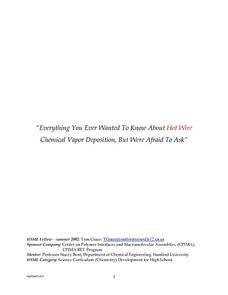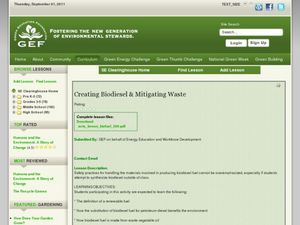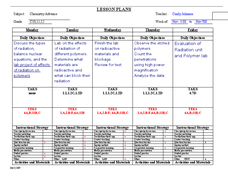Curated OER
A Comparison of Polymeric Liquids with Newtonian Liquids
Students concretely illustrate and define a macromolecule, observe the unique behavior of polymers and relate to their knowledge of molecules, and use the scientific process to determine the difference between Newtonian and non-Newtonian...
Curated OER
Beanie Baby
Students will explain the importance of soybeans. In this science lesson, students participate in making a "beanie baby" necklace. Additionally, students observe their soybeans for germination and growth for 7-10 days. Students record...
Curated OER
The Akron Global Polymer Academy Lesson Plan Format
Students identify types of garbage that will decompose quickly and the ones that do not. In this decomposing lesson students observe and record the photo degrading of six pack rings.
Curated OER
The Polymer Schoolhouse
Learners study various objects and determine plastic and non-plastic. In this creative lesson students get into groups and create a diorama to show the different properties they discovered.
Curated OER
Are Polymers Photodegradable?
Students study the term photodegradability and how it applies to the 6-pack loop ring. For this materials lesson students test photodegradability of the 6-pack plastic ring.
Curated OER
Polystyrene Containers
Students conduct experiments to determine the effectiveness of polystyrene containers at preventing heat loss. In this polymers instructional activity, students design an experiment to determine how effective Styrofoam burger containers...
Curated OER
Plastics by the Numbers
Students investigate plastic resins and their uses. In this plastics lesson plan, students describe major plastic resins and what they are used for, they compare and contrast the properties of plastic resins and they list products that...
Curated OER
Everything You Ever Wanted To Know About Hot Wire Chemical Vapor Deposition, But Were Afraid To Ask
To wrap up your year of general chemistry, have lab groups compete in a tot wire chemical vapor deposition (HWCVD) competition. With their foundation in chemical nomenclature, stoichiometry, and gas laws, each group completes several...
Curated OER
Creating Biodiesel and Mitigating Waste
Biotechnology pros produce their own biofuel using waste oil and fresh vegetable oil. They test the quality of their product using titration techniques and pH analysis. They write their observations and report their findings. Be aware...
Curated OER
Electromagnetic Energy and Its Spectrum
Your older elementary students investigate electromagnetic energy and the electromagnetic spectrum. They will observe 7 items represented in the electromagnetic spectrum and make a poster of all the things the items have in common. After...
Curated OER
It's the Slime Time
Students experiment to understand the basic concept of polymerization and to understand the dissolution theory. Student experiment with polymers to understand its behavior and the mechanical behavior of polymer networks.
Curated OER
Nuclear Chemistry
Students write and balance nuclear equations. For this chemistry lesson, students identify materials that block radiation using polymers. They collect and analyze data from the experiment.
Curated OER
Diaper Challenge
Students investigate the absorbency of certain diapers. In this inquiry lesson plan, students examine how much water the crystals absorb. They collect data and share their results in class.
Curated OER
Fishing Line Tests
Pupils test the strength of different fishing lines. In this chemistry lesson, students conduct the experiment by hanging various masses on the fishing line until it breaks. They record data, construct graphs and formulate their...
Curated OER
Science: Designer genes
Students engineer new organisms using biotechnology. In small groups, they write procedures, list benefits and drawbacks, and explain how their new organism might affect the environment. After creating their new organisms, they present...
Curated OER
Through Thick or Thin!!!
Students differentiate between high and low viscosity. Students collect, graph, and interpret data, then quantitatively measure polymer solids. Students experiment with a household example of an emulsion polymer.
Curated OER
Adventures With Super-Absorbers and Substance Solubility
Learners understand the concepts of absorption, swellability and solubility and recognize that science is all around us in our everyday lives and is fun to explore.
Curated OER
A Comparison of Polymeric Liquids with Newtonian Liquids
Students perform several tests on liquids. In this general science lesson, students compare the properties of polymeric and nonpolymeric liquids. They explain the composition and importance of macromolecules.
Curated OER
Making Plastic
Students experiment to create a plastic solution. In this science lesson plan, students use sodium borax and polyvinyl alcohol to create their solution, then identify, discuss, and chart observations on the end product.
Curated OER
WS 10.9 Plastic Recycling
In this recycling worksheet, students search for as many types of plastics categorized with the resin identification codes and fill in a chart for each plastic type. They identify the product name, the category the plastic is in, the...
Curated OER
Balloon Ball Bounce
Learners investigate energy conversions. In this physical science lesson plan, students make balloon balls to better understand rebound and the law of conservation of energy. The learners will use there balloon balls in a series of tests...
Lawrence Hall of Science
Photolithography
Examine the use of photolithography in the fabrication of circuit boards and other components. An advanced activity teaches pupils a process for transferring a pattern onto a surface. Using UV light and a light reactive substance,...
Curated OER
What Is Special About Polyethylene Food Storage Bags?
Learners participate in an investigation in which they compare a polyethylene bag designed for recycling or disposal with a polyethylene food storage bag. Students use hexane to determine the differences between the low density...
Curated OER
#21 Films, Fibers, and Solubility
Students are introduced to how the differences in solubility of materials are used in the manufacture of fibers and films. They are also introduced to the various processes used to make films and fibers. Pupils prepare fibers using wet...

























